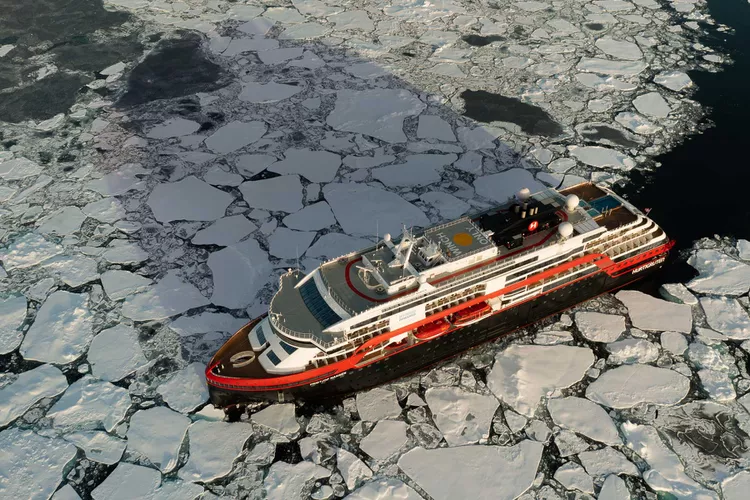1. Sustainable Cruising: A New Era
2. Environmentally Friendly Interior Designs
3. Innovations in Sustainability Efforts
Cruise lines are stepping up their sustainability cred with furnishings and fittings made from ever-greener sources.

On trips down the Peruvian Amazon, passengers on the Aqua Nera can soak up the moody riverscape and spot pink dolphins from the top deck. What they may not realize is that the handrails and carpets of the Aqua Expeditions ship are helping to protect, in a small way, the delicate ecosystems all around them. The railings and decking are made from Resysta, a wood-substitute material composed of rice husk, salt, and mineral oil, and many of the floor coverings are spun from recycled plastic, amounting to around one two-liter bottle per square foot.
The innovative ship, which launched in 2021, is emblematic of the efforts cruise lines are making to furnish their ships with environmentally friendly and ethically sourced materials. Consequently, they’ve made sustainability a tactile experience for guests while nudging the industry toward a greener future.
“Sustainable interiors have really moved to the top of the conversation,” says Thomas Westergaard, a vice president at Hurtigruten. The line’s Fridtjof Nansen is one example, featuring hybrid-electric engines and plenty of hygge, highlighted by flooring that’s Cradle to Cradle Certified, a global standard that indicates materials are sustainable.
The interiors experts at Tillberg Design of Sweden have collaborated with several lines, including Hurtigruten, Norwegian Cruise Lines, and MSC Cruises. When sketching out new ships, Tillberg designers draw from a “responsible supplier library” that includes curtains fashioned from recycled plastic and wall coverings made from renewables such as wood and wool pulp. Tillberg client Tui Cruises now uses Global Organic Textile Standard–certified cotton for bed and bath linens in every cabin on Mein Schiff 1 and Mein Schiff 2. On NCL’s newly launched Norwegian Prima, decorative tiles cut from recycled glass adorn the Surfside Café & Grill.

Meanwhile, Holland America Line has spent 18 months collaborating with Danish textile manufacturer Dansk Wilton to develop Origin, an undyed and fully recyclable carpet made from natural wool that debuted in all the staterooms on the Rotterdam in 2022. The companies are now working to upcycle carpets removed during refits to be reborn as signage and even furniture.
Moreover, many cruise lines are also making investments in significant sustainability efforts. In late 2020, the pandemic-battered cruise industry set a goal of pursuing net-zero carbon emissions by 2050. Now the challenge is to make that goal—or even the ambitious target of net zero—a reality.
The industry’s current focus rests on liquefied natural gas, or LNG: a cleaner-burning fossil fuel that reduces particulate emissions by as much as 95 percent, as well as overall carbon burn by about a fifth. The just-launched, 2,633-cabin World Europa from MSC is now the largest LNG-powered cruise ship. Carnival Cruise Line and Disney Cruise Line have also introduced LNG vessels in recent years.
Furthermore, more efficient “shore power” solutions are another avenue through which lines are reducing fuel consumption. Today, only a small percentage of cruise ports worldwide possess infrastructure that allows ships to connect to the local electrical grid, rather than running their engines while docked. (Seattle and Juneau, Alaska, are two locations with the technology.) Ships also require the right hardware—like that aboard the fuel-cell-equipped Silver Nova, which Silversea plans to debut this summer.

Other clean-engine technologies remain under development; new luxury brand Explora Journeys has ordered two hydrogen-powered vessels, though the first won’t arrive until 2027. Mein Schiff 7, ordered for European line Tui Cruises, is being built to accommodate methanol fuel, an alternative energy option first introduced in the 1990s that is experiencing renewed traction. Hurtigruten has announced plans for a zero-emissions ship to arrive on the Norwegian coast by 2030.
In recent times, most lines have reduced or eliminated single-use plastics aboard. Waste heat recovery systems are enabling ships like those in the Disney Cruise Line fleet to lower water usage: the innovative technology captures condensation from air-conditioning units to be reused for washing down outside decks.
A version of these stories first appeared in the December 2022/January 2023 issue of GoTravelDaily under the headlines “A Smoother Finish” and “Getting to Zero.”





